Trip Report 12-12-15
Last Saturday I tried something that I have never tried before and up until recently would never have even considered. I fished with a clear, colorless tenkara line. Not only did I catch fish, strike detection was surprisingly easly. If you fish weighted flies I would suggest trying it.
That sounds like heresy from the guy who started the movement to hi-vis fluorocarbon tenkara lines in the US, but read on.
Depending on how, where and when you are fishing, a clear line with keiryu markers might be a better option than fishing with a hi-vis line.
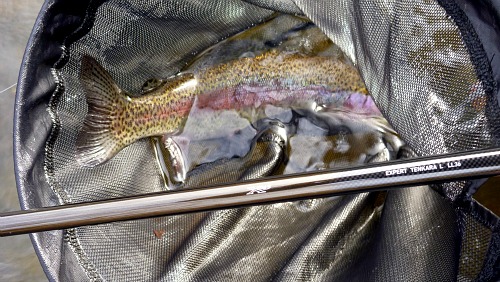
My primary goal on Saturday was to fish with the two new Daiwa Expert Tenkara rods. The Expert Tenkara L LL36 and Expert Tenkara L LL45M are both very nice rods that are definite upgrades from the Enshou rods they replaced. Both have much better damping, longer grips and are smoother casting. The LL45M is a multilength rod which can be fished at 4m as well as 4.5m. Both are longer when collapsed than the Enshou rods, which makes them worse for backpacking but better if you don't have to backpack (or fly) to your fishing locations (although they will fit diagonally in a full-sized suitcase).
Fishing the clear line was almost an afterthought. For the last few weeks I have been getting email tutorials from Paul Gaskell of Discover Tenkara in the UK. Several have covered French Nymphing, which is reasonably close to tenkara fishing but with one or two weighted nymphs rather than an unweighted wet fly. French nymphing is done with a clear line and a sighter (an in-line indicator). A short section of Amnesia or other brightly colored line between your tenkara line and your tippet, similar to what Tom Davis of Teton Tenkara uses, is an example of a sighter.
Most tenkara anglers do not use sighters, but instead rely on highly visible line (hi-vis level fluorocarbon, furled line or a PVC floating line) to signal a strike. That works well and offers no serious problems if you are fishing unweighted flies, which are fished relatively near the surface.
If you are fishing weighted flies, though (even modestly weighted flies like the Killer Bug I fished with on Saturday), either a hi-vis line or a sighter has a serious limitation.
To be most sensitive for strike detection, the end of your line (or your sighter) should be just above the water's surface. To be most effective, your weighted fly should be down near the bottom. The only problem is that the water depth varies constantly as you work your way upstream, fishing pools, riffles, pockets and runs. To keep your fly near the bottom and the end of your colored line above the surface, you have to change the length of your tippet - frequently.
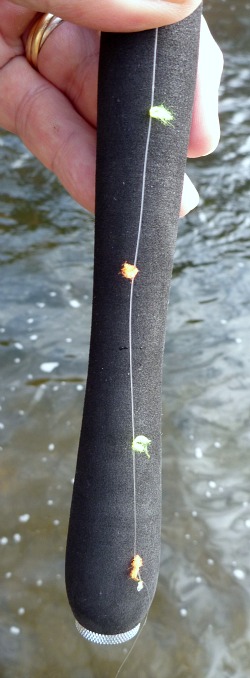
Nobody does that. Well, almost nobody. A friend that I fish with took a nymphing
class from a well known guide and author, and reported that they spent a
huge amount of time re-rigging to adjust for depth. That does make the
rig most efficient, but I think there is a simpler way.
That simpler way is to use keiryu markers and a CLEAR, COLORLESS tenkara line. Keiryu
markers are short bits of fluorescent polypro yarn tied to the line. Use three
or four, tied so that the lowest one is held above the water's surface. Space
them a couple inches apart and cut the tag ends short - less than
1/4". They should look something like the photo on the left. I found alternating fluorescent chartreuse and fluorescent orange was pretty easy for me to see. You may prefer different colors, but I would suggest using more than one color.
I have written before about using keiryu markers and a very light
keiryu line when fishing heavily weighted nymphs. On
Saturday, instead of using an extremely light tippet and
casting the weight of a heavy fly, I fished
with Varivas 1X fluorocarbon tippet, which is the the same weight as size 2.5 tenkara line. As with normal tenkara fishing, I was casting the weight of the line. The regular Killer Bug I was fishing does have a bit of weight, but the size 2.5 line was easy to cast with either of the Daiwa Expert L tenkara rods.
If you look closely, you can see my 5X tippet extend below the knot where it is attached to the 1X. For this method, use the same 5X or 6X tippet that you do now, with the tippet length determined by the shallowest water you expect to encounter. That way you can make all the adjustments in the markers by moving them up and down the 1X line. You can slide them up or down the line very easily and if tied on correctly they will stay where you put them. You can't slide them over the knot in the end of your line and down onto the tippet, though.
Because the line (1X Varivas fluorocarbon tippet) was clear, when the water got deeper I just moved the markers further up the line. Fishing with the markers still just above the surface, the fly was able to get deeper. The end of the 1X line was under the surface, but because it was clear it didn't alert spooky fish.
This is an easy way to adjust the depth of your fly, and let me tell you, it works. In fact, not having any colored line hovering over the surface may make your presentation even more stealthy.
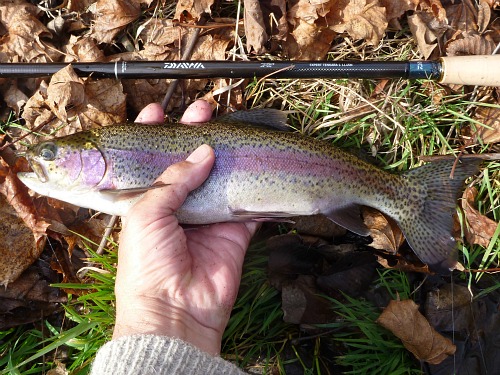
I started fishing with the Daiwa Expert L LL45M and a regular size 3 hi-vis tenkara line. After getting all the way through where I usually catch fish on that section of stream and not getting so much as a tap, I switched to the 1X Varivas and rigged four keiryu markers as shown above. Coming to a spot where I have caught fish in the past, but not for a long, long time, I hooked the 13" rainbow shown above. It put up a spirited fight but the full flex bend of the Daiwa soon tired it enough to bring it to the net. (And bringing a fish to the net is much easier if you fish the rod at 4m, with a 4m line, and then extend the rod to 4.5m after you hook a fish.)
Since the days are shorter now and I had other rods to try, I then switched to the Daiwa Expert L LL36. I transferred the line to the shorter rod, cutting a bit off the rod end of the line so I wouldn't have to re-rig the markers and tippet. I then took a few minutes trying to get a good photo of the markers. (You absolutely cannot photograph keiryu markers against the water with a point and shoot camera because it will always focus on the water rather than the markers).
Once I got an acceptable photo of the markers (above left) I went back to fishing. Since it is not unusual to find more than one fish in a good location, I started casting to pretty much the same spot where I had caught the fish on the Daiwa Expert L LL45M. Second cast - Bang! Fish on.
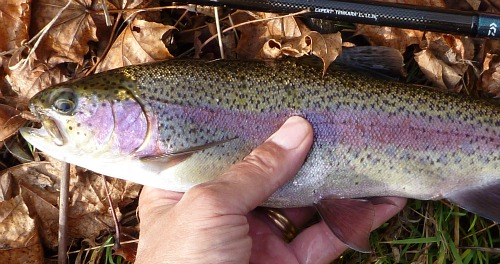
When I got it out of the net to take a photo it looked like it was
the same fish I had just caught. I had to wait until I got home and
could blow up the photos to be certain, though.
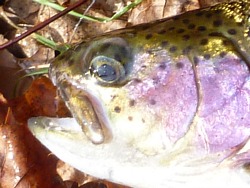 Caught with LL45M. Photo 12:32PM
Caught with LL45M. Photo 12:32PM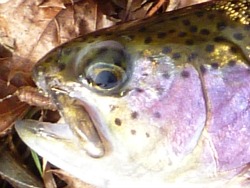 Caught with LL36. Photo 12:45PM
Caught with LL36. Photo 12:45PMThe spots were the same on both fish, as was the injury on the upper jaw (most likely from someone striking too hard).
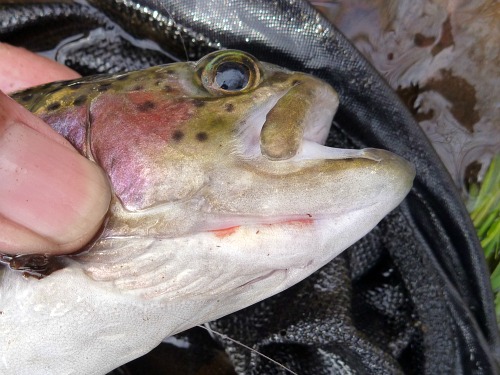
If that wasn't enough (and really, it was; the spot pattern on a fish is like a fingerprint - no two are identical), both fish had something I have never before seen in stocked rainbows in New York state. There were red slashes under the jaw - just where you would expect to see them on a cutbow. I have never heard of the state stocking cutbows, but I don't know if those slashes ever show up on pure strain rainbows (or whether the state's broodstock isn't actually as pure as I had thought).
Sure enough, it was the same fish! Both times caught with the same Killer Bug! Now obviously, the Killer Bug is a great fly, but the entire presentation had to be flawless the second time to fool the same fish after it had already been caught. Getting the depth right and not having the end of a brightly colored line down under the surface may have been critical.
For both catches, the keiryu markers performed perfectly. Held just a few inches above the surface, they very clearly indicated that a fish had taken the fly.
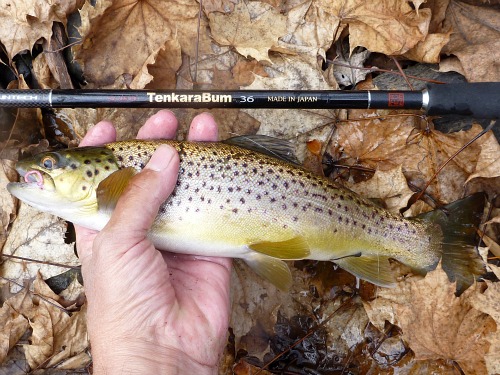
A little while later I moved to a different spot on the stream and switched to a TenkaraBum 36 and Pink Chenille Worm without a split shot. Still using the 1X Varivas as the line I discovered that it did not work well when casting an unweighted fly.
The keiryu markers create wind resistance when casting and I felt they'd had too great an impact on the cast with an unweighted fly. It may have worked better with a heavier line, and I have since gotten in some 0X tippet (equivalent to size 3 line) and some -2X tippet (equivalent to size 4 line) to test. Still, I think the main benefit of the clear line and marker rig comes when fishing weighted flies. The heavier tippets should work better with stiffer rods that don't cast 1X easily.
When I put a split shot on the line a few inches above the Pink Chenille Worm the line cast as it should. As with the earlier fish, the markers again provided an extremely clear indication of the take.
I did find that it is a bit tricky to cast the line without having the markers even touch the water's surface. Even though they are made of polypro yarn, which floats, they do get wet and when wet they get heavier. When they get heavier they get even harder to keep from landing on the surface when you cast. A shorter line definitely works better than a longer line and stopping the forward stroke on the cast with the rod still high is essential.
Unless you fish only weighted flies, I would not recommend scrapping your hi-vis line in favor of a clear line and keiryu markers. For unweighted wets the hi-vis line is definitely better (less wind resistance). Besides, since unweighted flies aren't going to get to the bottom anyway, controlling depth really isn't an issue.
For fishing weighted flies, though, you might want to try the clear fluorocarbon line and markers. It is very easy to adjust the markers for depth, which is one of the key problems that nymph fishermen face. Using heavy tippet material that is the same weight as tenkara line allows you to cast just like you do now. Use the same 5X or 6X that you do now to connect your fly to your line.
One other reason to have some keiryu markers with you is that they are much easier to see in the low light of evening than even the best hi-vis fluorocarbon line. Just leave the tag ends a bit longer. In low light conditions when you need any help you can get, go ahead and tie them to your hi-vis line.
Update 12-23-15
In response to my comment "the spot pattern on a fish is like a fingerprint - no two are identical" I received an email from one of my customers, who is a fish biologist. He passed along a link to a free software program that compares spot patterns on the fish in your photos (used by biologists for population studies). I have not downloaded it because in well over 50 years of fishing can only think of two times where I thought I'd hooked the same fish twice (once I could prove it, the other I couldn't because I didn't land the fish). Still, it might be fun to play with. Here's the link, thanks to Chris S in Calgary: http://www.reijns.com/i3s/about/I3S_about.html
TenkaraBum Home > Trip Reports > Trip Report 12-12-15
“The bitterness of poor quality remains long after the sweetness of low price is forgotten” - Benjamin Franklin
"Be sure in casting, that your fly fall first into the water, for if the line fall first, it scares or frightens the fish..." -
Col. Robert Venables 1662
As age slows my pace, I will become more like the heron.
We've all had situations where seriously chewed up flies kept catching fish after fish after fish. It is no sin to tie flies that come off the vise looking seriously chewed up.
Warning:
The hooks are sharp.
The coffee's hot.
The fish are slippery when wet.
Beware of the Dogma
Seriously, all the hooks sold on TenkaraBum.com, whether packaged as loose hooks or incorporated into flies, are sharp - or as Daiichi says on their hook packages, Dangerously Sharp. Some have barbs, which make removal from skin, eyes or clothing difficult. Wear eye protection. Wear a broad-brimmed hat. If you fish with or around children, bend down all hook barbs and make sure the children wear eye protection and broad-brimmed hats. Be aware of your back cast so no one gets hooked.
Also, all the rods sold on TenkaraBum.com will conduct electricity. Do not, under any circumstances, fish during a thunder storm. Consider any fishing rod to be a lightning rod! Fishing rods can and do get hit by lightning!
What's in stock?
Kurenai II AR 30F
Kurenai II AR 33F
Kurenai II AR 39F
TenkaraBum 33
TenkaraBum 36
Furaibo TF39
Furaibo TF39TA
Nissin Oni Tenkara Line
If you enjoy spin fishing or baitcasting please visit my sister site Finesse-Fishing.com.


